#people thought they were remaking birth of a nation for a little bit
Explore tagged Tumblr posts
Text
From Script to Screen: The Strange Alchemy of ‘Bad Lieutenant: Port of Call New Orleans’ by Soheil Rezayazdi
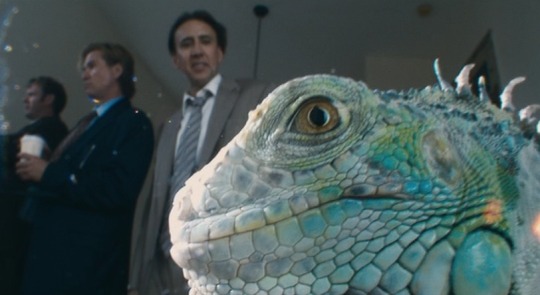
The word “iguana” doesn’t appear in the shooting script of Bad Lieutenant: Port of Call New Orleans. And why should it? Written by veteran TV writer William Finkelstein, the script unfolds with the cause-and-effect logic of a tight police procedural. Prior to penning Bad Lieutenant, Finkelstein wrote more than 50 episodes of L.A. Law, created and wrote on Brooklyn South, and contributed to such cop show staples as Law & Order and NYPD Blue. The man knows how to write a coherent crime drama. He’s devoted his career to the genre, mastering its plot points and character arcs for network television.
So why, in Bad Lieutenant, does a routine scene of police surveillance devolve into a full minute of shaky close-ups of iguanas? Why do scenes end with mystifying non-sequiturs like “Shoot him again...his soul is still dancing”? Why does its protagonist enter a bar shouting, “Sup! Sup! Sup, motherfucker!” for no reason? And why does he aim a gun at an old lady’s head and seethe “Maybe you should drop dead, you selfish cunt!” long after a director should have shouted “cut”?
William Finkelstein wrote none of that. His script originated in the early 2000s as a New York-set TV pilot. Over time, he reworked the material—first into a feature, then into a New Orleans noir. He finished revisions on the script in 2008 as the film was in production. The final script, which he sent me prior to our recent meet-up at an Italian bakery in the West Village, bears the signature of a police procedural master craftsman. Over espressos and lemon ices, I implored Finkelstein to discuss the brazen changes made to his script by the erratic tag team of Nicolas Cage and director Werner Herzog.
Our discussion, along with a close look at the unpublished shooting script, reveals how many of Bad Lieutenant’s most singularly strange moments were born.
“I always wanted to pull back to the procedural nature [of the script],” Finkelstein said, “and Werner basically didn’t give a shit about any of that.”
---
Bad Lieutenant: Port of Call New Orleans is a true curiosity. Neither a remake nor a sequel to Abel Ferrara’s 1992 Bad Lieutenant, the film attempts to turn that film’s premise—a cop with a severe drug problem—into a franchise. Finkelstein likened the connection between his film and Ferrara’s to the Bond series. “From Russia with Love is not a sequel to Dr. No,” he said. “It’s a different movie with different bad guys and settings, but there’s a character in the midst of it—who’s played by different people over the years—who has certain traits that make James Bond James Bond.”
And so the refined Bond martini, shaken not stirred, becomes the bump of coke before work, the hit of crack with your local dealer, the shot of heroin to end the night. Take your pick. Both bad lieutenants love it all. Not surprisingly, there’s no word yet on a third installment to a film franchise whose trademarks include hardcore drug use, gambling debts, and sexual bribery.
The 2009 film is a gleeful exercise in provoking head scratches, raised eyebrows, dropped jaws. Where to start? That a Nic Cage cop drama is the biggest budgeted film of Werner Herzog’s career? Or how about its supporting cast, a grab bag of the formerly famous (Val Kilmer, Fairuza Balk, Xzibit) that gives the film its straight-to-video flavor? Or maybe we focus on the title, Bad Lieutenant: Port of Call New Orleans, a name as indecisive and unwieldy as the film itself?

Above all, though, we have the enchanting interplay between three distinct voices: Herzog, Cage, and Finkelstein. The three operate as something of a jazz trio— Finkelstein keeps time while Herzog and Cage solo over his material. Each player takes turns taking control of what’s on screen. Cage brings the Tourettic outbursts of a repressed superstar unchained. Herzog injects the film with lyrical (and often very goofy) interludes. And Finkelstein gives contrast to his partners’ more self-indulgent noodling. Together, the three don’t exactly harmonize; their agendas clash on the screen, birthing moments of wondrous strangeness. You either dig the contrapuntal pleasures, or you hear nothing but noise.
This piece focuses on the film’s noisiest moments: those flashes of improvisation and left-field obsession smuggled into Bad Lieutenant. I select four scenes where the film erupts into delicious chaos. These are the scenes where a genre picture, penned by an industry veteran, morphs into a kind of madness no screenwriter could dream up.
---
“You’re the fucking reason this country’s going down the drain!”
A police officer investigates a homicide while battling his own demons. Bad Lieutenant, for all its digressions, hinges on a fairly straightforward premise. As the film’s tagline cutely puts it, the only criminal Lt. Terence McDonagh can’t catch…is himself. Our protagonist stumbles around New Orleans, getting into all kinds of trouble, as he gathers evidence against the likely perp, a local drug dealer named Big Fate (Xzibit). McDonagh has shades of the great stoner detectives—The Dude, Doc Sportello, Altman’s Philip Marlowe—only he doesn’t shy away from conflict; he seeks it out like a commuter with low blood sugar.
His biggest meltdown arrives in a luxury nursing home. McDonagh’s there to interrogate Binnie, a nursing home assistant, on the whereabouts of her grandson. In the script, he badgers Binnie and a patient in her care, an elderly woman in a wheelchair. Binnie refuses to talk—until McDonagh cuts off the patient’s oxygen supply. Aghast, Binnie gives up her grandson’s location. McDonagh reattaches the oxygen tubes, having extracted the information he needs to move the plot forward, and leaves. End scene.
This two-page exchange runs a sadistic three minutes in Bad Lieutenant. The unscripted touches start right away: Cage hides behind the old lady’s bedroom door as she enters, surreally shaving with an electric razor. He attacks this material with the whisper-or-scream volatility of his famed freakouts. Dialogue-wise, he sticks to Finkelstein’s words for the first two minutes, drawing out lines like “Children...were executed” for maximum menace. From there, he transforms the moment into macabre humor. Cage introduces a gun into the scene, shoving it up against Binnie’s temple as he fumes, “Where the fuck is he?” Once he gets his answer, Cage extends the scene with a virtuoso verbal assault on the old lady. “Maybe you should drop dead you selfish cunt!” he erupts after a few seconds of silence.
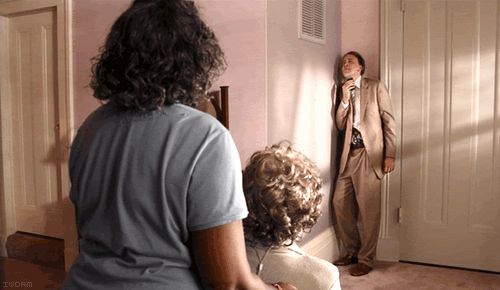
It’s too much to print here in full. You can find it in any Nic Cage supercut worth your time.
“You’re the fucking reason this country’s going down the drain!” he screams to close the scene, a head-spinning non-sequitur from a character who’s never expressed concern for the state of the nation.
For Finkelstein, the scene was way too much.
“When I first saw it I thought, ‘Wow, we can’t do this,’” he said. “‘This is terrible. It’s so extreme. It takes us out of the scene.”
Finkelstein wrote the sequence as an homage to the 1947 noir Kiss of Death, in which Richard Widmark shoves a woman in a wheelchair down a flight of stairs. He saw an early cut of the film and dined that night at Herzog’s house. He decided, rather than suggest a dozen small edits, he would focus on two or three big asks. This scene was one of them. Cage’s assault serves no real purpose. It’s just a full minute of over-the-top Cage rage. I’d imagine most writers would question the inclusion of such a tone-shattering addition to their script. Herzog overruled him.
“I saw it again at the premiere, and I’m sitting there in the theater and I just loved it,” Finkelstein said. “I thought it was funny as hell. The extreme nature of the annunciation is what sold it. I think I was a little conservative, a little cautious.”
“I was so happy that nobody listened to me in the end,” he said.
---
“What’re these fucking iguanas doing on my coffee table?”
Little can prepare first-time viewers of Bad Lieutenant for the iguana interlude. In perhaps Herzog’s most ostentatious addition to the script, he stretches less than a page of script action here into two minutes of on-screen delirium. It’s the film’s most infamous scene, a narrative and aesthetic sideswipe of the highest order.
On the page, the moment unfolds without much incident. McDonagh arrives in an apartment being used to surveil a drug dealer. He has a routine exchange with two officers about the suspect’s whereabouts. McDonagh and Stevie (Val Kilmer) disagree about whether to call the SWAT team. Soon, all five cops leave to apprehend the suspect. No outbursts, no obscenities, no iguanas.
In the film, Herzog opens this sequence with a shot of Cage snorting heroin in a bathroom stall. This bit appears elsewhere in the script; Herzog moves it here, we can presume, to prime us for the psychedelic journey to come.
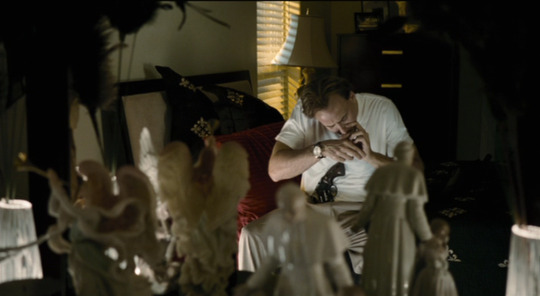
Cage enters the surveillance site with an un-holstered gun comically bulging out of his pants. Finkelstein was on set the day Cage decided to wear his gun like this throughout the film. Initially, he felt compelled to protest.
“There’s times when an actor wants something like this, and you got to say no,” Finkelstein said. Having worked on cop dramas for decades, he took pride in getting these details right.
“Cops don’t carry their guns like that,” he said. “But as extravagant as this was as a gesture, Nic understood something about this character. He was playing this guy bigger than I’d imagined, but in fact he was right and I was too cautious.”
Heroin in his veins, gun in his groin, Cage storms into the scene and spots two iguanas matter-of-factly lounging on a coffee table. He stutters in extreme agitation, turning script lines like “Let ’em stay there” to “Naw! No...just no SWAT, let ’em stay there.” He then drifts into a fugue state with the invisible iguanas. Amid a story of cops and criminals, Herzog asks us to stare at garish close-ups of the animals for 60-some seconds. Louisiana native Johnny Adams wails on the soundtrack. To make the narrative rupture even more pronounced, he films the ordeal in ugly, consumer-grade digital video.
I’m not so concerned with what this all means. Animals and nature have long fascinated Herzog, from the “fiendish stupidity” of chickens to the “obscene, explicit malice” of the jungle. Animals permeate Bad Lieutenant—fish, iguanas, gators—and almost all of them were introduced by Herzog. As a viewer, a part of me wants to rationalize these moments. Perhaps Hurricane Katrina’s floodwaters brought the wilderness into the city, turning New Orleans into a literal asphalt jungle? Or maybe it’s more intuitive: “There is nothing more wondrous,” Herzog has said, “than seeing Nicolas Cage and a lizard together in one shot.”
Finkelstein gave his blessing for the iguana hallucination, despite its total disruption of the story. The scene came at the expense of an action sequence Finkelstein had written. In the shooting screenplay, Cage’s character has a coke-fueled fight with some strangers at a gas station. Herzog refused to shoot the scene to ensure his iguanas made the final cut. Finkelstein tried to sell him on the merits of the rest stop melee, and lost.
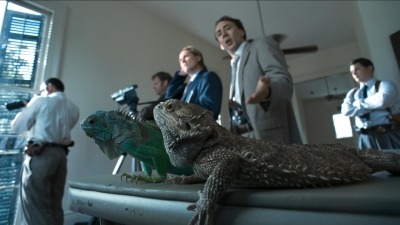
“Herzog said ‘I think we’re going to go long, and then [the producers] are going to make me lose my iguanas—and if they make me lose my iguanas I feel like I can’t be a filmmaker anymore,’” Finkelstein recalled. “And I thought ‘Whoa, this cat is serious. He’s not fucking around.’ I just had so much respect for him as an artist. I didn’t give a good goddamn if he shot the scene or not once he said that. That beats anything.”
---
“To the break of daaaawn, baby!”
Bad Lieutenant’s script detours tend to arrive at the start or end of a given scene. Consider the above examples: Herzog and Cage hit the scenes’ narrative beats, and then they start riffing. As Finkelstein put it, the two “always knew what had to happen in the scene.” Once they hit those notes, they had carte blanche to treat the script like mere bullet points to a freeform lecture of their choosing.
“Nicolas knew that sometimes after a scene was shot I would not shut down the camera if I sensed there was more to it,” Herzog wrote in 2009. “I simply would not call ‘cut’ and leave him exposed and suspended under the pressure of the moment.”
The film’s catchphrase grew from this loose set dynamic. Toward the end of Bad Lieutenant, Cage’s character cons Big Fate to both gather evidence against him and score some of his drugs. In the script, McDonagh, Big Fate, and his men share a moment together after a successful drug deal. McDonagh demands his cut of the money and a cut of the drugs. He pulls a gun on Big Fate and wins the exchange, closing the scene with an unambiguous threat to a car full of drug dealers: “I’ll kill all of you.”
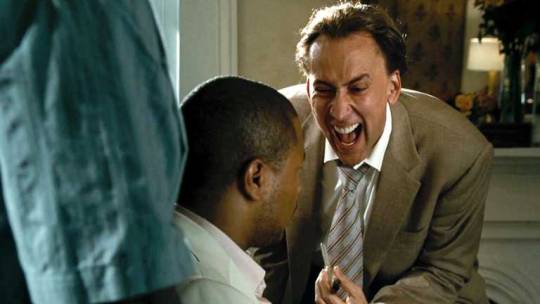
Cage doesn’t end the scene there. To begin, he colors the exchange with spastic ad libs like “Sup!” to get the men’s attention. The actors stray from the particulars of the screenplay, but they convey all the key information to move the story forward. Then the scene trails off into loopy nonsense. Cage waves his gun around like a toy and, sensing radio silence, mutters—and then roars—“I’ll kill all of you...to the break of dawn. To the break of daaaaawn, baby!”
You can see the smirk sneak onto Cage’s face just before he opens his mouth. Clearly pleased with himself, he delivers the line with the Elvis-like drawl he used in Wild at Heart. All four actors erupt in laughter, and suddenly it’s as though we’re watching a closing credits gag reel. Cage swings the mood from sinister to silly; Herzog, the enabler, lets him get away with it.
“This was pure Nic,” Finkelstein said. “That was one of my favorite moments because he can’t help but get this smile on his face when he says it. He’s so enthused.”
I smiled, myself, upon hearing this. As a viewer, I’d long wondered if Finkelstein found moments like this offensive. Here’s Cage, after all, undercutting his words, cracking up fellow actors for kicks. It could be interpreted as mockery. For Finkelstein, though, Cage’s untethered rambles “all seemed to work of a piece.” Finkelstein had years of experience making on-set changes to other writers’ scripts as a TV showrunner. His words, he told me, need not be “cherished” by an actor struck with inspiration.
“The story felt like it could incorporate all that,” he said. “There was a basis for it because this guy was fucked up all the time.”
---
“Shoot him again...his soul is still dancing.”
The script revisions get downright operatic by the film’s climactic shootout. Over an eternal five and a half minutes, Cage and Herzog here transform the script’s most violent moment into a surreal and comic medley of their wildest impulses.
They make far too many edits to detail them all. In Finkelstein’s text, the scene begins as a meeting between Big Fate, his henchmen, and McDonagh. Spirits high, McDonagh smokes crack with the men to test out their new product. He proposes that, in lieu of his cash payment, he gets a cut of the dope. The men agree, and McDonagh spoons his share into a baggie. He then invites Big Fate to take a hit from his “lucky crack pipe.” McDonagh, we later learn, will plant the pipe at a crime scene to seal his case against Big Fate.
A trio of thuggish debt collectors arrives at Big Fate’s home to shake down McDonagh for the money he owes them. McDonagh suggests they take his dope as payment; the head gangster, Dave, threatens to take all of the dope, Big Fate’s included. A tense moment follows. The debt collectors reach for the dope on the table; Big Fate and his men shoot all three of them. “Clean this shit up,” Big Fate says to close the scene.
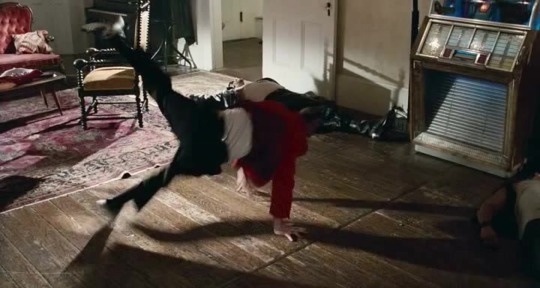
Cage and Herzog’s gonzo take on this material is at once faithful and ludicrous. The scene begins, as in the script, with the characters in a celebratory mood. The four men smoke as Xzibit orders his men to “light the Caucasian’s rock”—the first of many ad libs smuggled into the scene. For Cage, the drugs are a green light to go berserk. He proposes a business idea and explodes into a pipe-bursting laugh few on this earth could imitate. From there, the floodgates open. Cage runs through a nonsense story about a football player who sprouts antlers. We’ve all been there: loaded, desperate to tell a story with no point. Wild-eyed and blissed-out, he ends the unscripted monologue with another abrasive laugh. Pure Cage, uncaged.
Xzibit and his men worry Cage might die from the crack intake. Here, the actors use snippets of Finkelstein’s dialogue about other drug users dying and apply it to Cage, given how feral he’s decided to play the scene. “Easy, easy, easy...cuz I’m not Eazy-E!” Cage retorts, another improv line that makes Xzibit laugh.
From there, the scene plays out as written for two minutes. Finkelstein, a native New Yorker with an agreeably gruff voice, plays Dave, the lead debt collector. The confrontation between him, Xzibit, and Cage ends in a shootout set to “Lost John,” the same song Herzog used for the dancing chicken sequence in Stroszek.
Cage then passes the freak flag to Herzog. Instead of “clean this shit up,” Herzog has Cage implore the gangsters to shoot Finkelstein again because “his soul is still dancing.” Cage erupts into his asthmatic laugh as Herzog pans to reveal a breakdancer dressed like Finkelstein spinning near his dead body. Cage stares ahead, transfixed by the breakdancing soul. An iguana saunters through the room, an emblem of his hallucination. A shootout has devolved into a freakout.
None of this, of course, was scripted. It’s all too perfect: A screenwriter gets his work butchered, and then he gets killed on camera. Finkelstein called these edits “happy bastardizations.”
“Some of that big shootout was improvised, yeah,” he said. “That thing about the gazelle sprouting antlers, Cage made that up. The breakdancing was Werner. Absolutely Werner.”
Finkelstein compared Bad Lieutenant to other gangster films freed from the shackles of genre, from Breathless to the crime dramas of Jean-Pierre Melville. He also likened it to Cop Rock, a short-lived ABC show he co-created. A true curio, the 1990 show operated as part cop drama, part musical. It was a fascinating, supremely awkward marriage. “Audiences were not happily startled,” as Finkelstein put it. Though he didn’t write it that way, Bad Lieutenant became a similar experiment in police procedural storytelling.
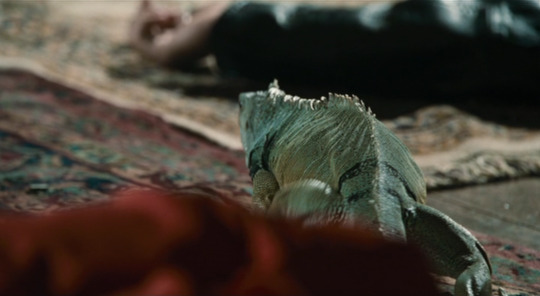
“There’s a tradition of being able to take the form and blow it up and make a movie that’s more lyrical and not realistic,” he said. “I think that’s what we all wound up doing.”
---
Who captains this ship? The answer changes from scene to scene, shot to shot, line to line. A big-name actor, an art-house iconoclast, and a veteran TV writer each take turns steering. Finkelstein guides much of the first act; his instincts as a successful writer/producer orient viewers into this world. Herzog takes the film on its strangest journeys, refashioning this material into an exploration of what he calls “the bliss of evil.” And Cage grabs the mic like a drunk wedding guest, holding viewers hostage to his artful, overlong eruptions. Each contributor has his marquee moments. Like a stoner pizza topped with cream cheese, bacon, and Nutella, it shouldn’t work—but it does.
Bad Lieutenant reveals cinema for what it is: a messily collaborative medium. Every film is the work of many voices. What makes the film wonderful is that, despite their strong and distinct personalities, Cage, Herzog, and Finkelstein’s voices don’t compete; they complement. They produce a sound neither could create on his own.
Finkelstein stressed this point throughout our talks. His impulses did, at times, conflict with the liberties taken to his work. He returned several times to Cage’s unhinged attack in the nursing home. Finkelstein’s voice, calibrated over decades on television, couldn’t make sense of such excess. Of course he came around. Had he been in charge that day, though, he “almost assuredly would have pulled back,” he told me. “That Nic didn’t is a testament to one of the joys of a collaborative process.”
The word “alchemy” feels appropriate for a film this volatile. To watch Bad Lieutenant is to witness a bizarre and unlikely combination of elements collide on a screen. We’ve seen these elements before, in isolation: Cage’s tantrums, Herzog’s lyricism, Finkelstein’s cop drama chops. Together, they produce something new, unclassifiable—a drug you’ve never taken before. As with all great cult films, my recommendation comes with a warning: Be careful. It’ll mess with your head.
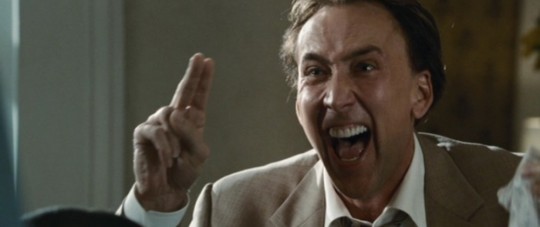
#werner herzog#nic cage#nicolas cage#william finkelstein#bad lieutenant#bad lieutenant: port of call new orleans#xzibit#val kilmer#abel ferrara#nypd blue#law & order#iguana
8 notes
·
View notes
Text
Moral Dilemmas in Science Journalism about Genetics Research: The case of gene drives
Guest post by Rebecca Hardesty, Ph.D.
Rebecca Hardesty is a postdoctoral scholar in science education and communication at UC San Diego in its Division of Biological Sciences and the Teaching + Learning Commons.
***
The New York Times Magazine rang in the New Year with a featured piece by Jennifer Kahn recounting the promises and perils of one of the newer advances in genetics research: the gene drive. As someone who has worked alongside biologists of various stripes for the past six years as a social scientist and modest historian of genetics, I found this article particularly striking. On the face of it, the journalist presented a compelling account of: a) the gap in understanding between the geneticists and general audiences; b) how gene drives could support the eradication of malaria; and c) the moral dilemmas associated with this kind of research. However, this story is more than just a well-researched and provocative piece – it is a paradigmatic example of what accepted science journalism is, and has been, for the last fifty years.
The standards this genre of journalism upholds support journalists writing informative and thought-provoking accounts of scientific advances. However, they also privilege reporting that abstracts biological work from the historical context which informs its significance. Even more significantly, this sort of journalism continues to uphold the view that scientists are always a bit removed from ordinary life and its accompanying moral concerns. This is not to take away from the article or the accuracy of its information on gene drives. However, I bring up this particular article as means of showing how the conventions of science journalism skew what goes on in actual scientific practice.
I encourage you to read the article itself, but I will relay the information it presents on gene drives as a means of first showing how the ethical issues the author identifies are understandable. Then I will show that they are not concerns specific to gene drives, but ones that have pervaded reporting on genetics research since the 1970s with little change.
About Gene Drives
Kahn begins with a surreal account of “Science Speed Dating,” an event that people in the entertainment industry attended in the summer of 2018 to learn about science so that its cinematic depictions were somewhat accurate. It was at this event a UC Irvine biologist, Anthony James, presented his work on mosquito-borne diseases, including malaria. In his research, James uses gene drives. Gene drives are a genetic engineering technology that changes the likelihood of a particular gene variant being transmitted throughout the population of a species. Gene drives are fairly flexible as a technique and one can use them add, delete, or modify genes. In the context of malaria research, in 2015, James and his laboratory genetically modified mosquitoes to resist the parasite that causes malaria.[1]
However, as Kahn shows, gene drives are still in their infancy and have not been tested outside of laboratory settings. And this is for good reason. They have the potential to fundamentally disrupt the genetic evolution of a species. This is because, when a gene drive works properly, it affects not only the current generation of an organismic population, but all of its subsequent generations. The Hollywood framing of Kahn’s piece makes a lot of sense.
This technology immediately conjures up narratives of science-gone-wrong where a group of well-meaning scientists accidentally create mosquitoes that spread especially virulent forms of the diseases they carry. Or perhaps an entire ecosystem is affected in unforeseen and horrible ways because of a seemingly innocuous modification to one species. There are also the predictable storylines of this technology being weaponized or used to wipe out an entire species. This is not a new trope in science fiction. For example, the Mass Effect video game trilogy contains a species which was involuntarily genetically modified to limit the number of live births, and this gene was propagated to all future generations of the alien race.
Kahn continues by recounting the rocky road gene drives have had gaining trust and acceptance from activists and general audiences. Significantly, the author highlights the comments that came out of the United Nations Convention on Biological Diversity in 2018 in which activists “compared gene drives to the atomic bomb” (Kahn, 2020). While the activists frame gene drives in a highly-charged way, it is not dissimilar to Kahn’s own framing of this genetic engineering technology as an immediate moral dilemma. Nor is this a new way of conceiving of the morality associated with genetics research. Part of my own research has focused on journalistic work on disease-oriented genetics research. To highlight the persistence of this approach to science journalism, I will take as a comparative example the April 1971 Time magazine special issue, “The New Genetics: Man into Superman.”
Disconnects between Scientists and the Media
I came across this Time magazine special issue when I was reviewing the transcripts of a meeting of the Salk Institute’s Council for Biology in Human Affairs that took place in Cold Spring Harbor on June 11 and 12, 1971. During this meeting, founding members of the Salk Institute, as well as external members of the Council, met to discuss several things. These included the recent developments in genetics research, how the public might respond to them, and how to inform the public about the significance of these developments. The conveners were particularly concerned with cloning, reimplantation, prenatal genetic diagnosis, and gene therapy.
The Council was split on whether the public was sufficiently educated on genetics research to make informed decisions about domains of life that the recent advances could, one day, affect. Some members were particularly concerned that the public’s lack of understanding would lead them to fear this branch of biological research and group it in with ongoing chemical warfare research that resulted in the gases being used in Vietnam, or even the kind of research in physics that lead to the atomic bomb in World War II. This issue of fear and public trust was set aside after the Council members referred to this Time magazine issue as evidence for why they did not need to engage in future efforts to educate general audiences. I tracked down this issue and was surprised to see that this was not the reassuring set of articles I assumed they were. In fact, they painted quite an alarming portrait of geneticists.
The cover of this issue shows human figures consumed by red DNA double helices against a dark background. The color palette is similar to radiation warning posters and signs used during the Cold War. The New York Times Magazine article has similarly disturbing imagery. In this case, it is an enormous black fruit fly (Drosophila melanogaster) with glowing red eyes that would not be out of place in a Giger-inspired horror film. While these were fruit flies that James, the biologist, modified to have fluorescent eyes, the magazine could have chosen to feature a less sinister fly with green or blue eyes. Still eye-catching, but less demonic.
Portrait of the Scientist as Outside Everyday Life
Textually, the Times magazine and the New York Times Magazine articles start with embedding their discussions of genetics research in fictional portrayals of moral dilemmas in science. The Times piece begins with a quote from Dr. Zhivago which, in the context of the article, brings together fears of communism, nuclear war, and science’s ability to change the nature of life,
“Reshaping life! People who can say that have never understood a thing about life—they have never felt its breath, its heartbeat—however much they have seen or done. They look on it as a lump of raw material that needs to be processed by them, to be ennobled by their touch. But life is never a material, a substance to be molded. If you want to know, life is the principle of self-renewal, it is constantly renewing and remaking and changing and transfiguring itself” (Pasternak, 1957).
While Kahn does not draw on the still-relevant quote from Dr. Zhivago, her early introduction of the “Science Speed Dating” as well as use of the voices of television producers, gives weight to the fictionalized version of science. Even though Hollywood isn’t a litmus test, as Kahn says, for how people outside of the sciences and the entertainment industry will evaluate gene drives, media representation is influential.
By using the cinematic version of genetics research as a contrast with biologists’ statements about their technical work, it does not make them more relatable. For the majority of people, fictional depictions of science are much more familiar than scientists own descriptions of what they do. And along with these depictions comes the sensationalized versions of the moral issues that are associated with technological advances.
Contributing to the depiction of biologists and geneticists as apart from the familiar and everyday, both articles show researchers operating outside of ordinary life. The Times magazine article uses quotes from researchers abstractly speculating about the moral implications of genetics research in their other work, which was not representative of academic sentiments at that time. One example is Robert Sinsheimer proclaiming that because of their increased understanding of genetics, scientists now understand the origin of life and have the ability to design humanity’s future (Time, 1971, p. 53). The article continues by reflecting on the potential genetic damage caused by the radiation from the atomic bombs used in Nagasaki and Hiroshima. It then quotes Theodosius Dobzhansky’s ethical dilemma,
“If we enable the weak and the deformed to live and to propagate their kind,” he says, “we face the prospect of a genetic twilight. But if we let them die or suffer when we can save or help them, we face the certainty of a moral twilight” (Time, 1971, p. 53).
This is a portrayal of scientists abstractly and coldly speculating about how they ought to dictate who lives and dies. The New York Times Magazine article is not sensationalistic; however, it shows scientists divorced from mundane concerns or responsibilities. In one photograph, Valentino James, a biologist at UC San Diego, stands imposingly in front of a refrigerated storage unit. In a vignette, researchers casually work all Christmas day debating the ethical and safety ramifications that their research may produce. While this goes by quickly, it does paint a portrait of scientists being removed from everyday concerns like holiday cooking, dealing with relatives, needing to take a vacation, childcare, or spending time with family.
In Kahn’s article, scientists are defined by their work, not the human feelings and drives that motivate us all to act as we do. Having spent years working alongside biologists, there is always a rich story to be told about how they care about involving their students in their research, their concerns about teaching (even if they are research faculty), why their work matters to them. Relatedly, it is usually compelling to hear why they chose to stay in academia as opposed to pursuing more lucrative (and possibly less stressful) careers in industry. There are also humanizing little stories to be told of how an experiment went wrong in a surprising way, how a lab decided on cleaning duties, or that meeting where the whole lab debated about where in their conference room they ought to hang a painting.
Not only would it be nice to hear these stories, science journalism needs them to revise the portrait of the scientist as an eccentric researcher who is unlike you or me.
Reconceiving Scientific Dilemmas
Finally, I want to take a step back and look at the context of these two articles. Half of the Time magazine issue was devoted to news and anxieties about the Vietnam war, the Middle East, continuing fallout from WWII, socialist uprisings, and disapproval of president Nixon. The New York Times Magazine issue had a similar tone. There was a focus on the US’s involvement in foreign conflict, changes in the Middle East’s political landscape, and there was also an article devoted to WWII and another focused on concerns about the Republican party. While much as changed in the world, much has remained the same. This includes the structure of both these articles and the way in which they are pitched. Both focus on the grand moral concerns concerning genetics research when there are more immediate issues such as:
How can this work, which requires national and international collaboration and successful communication, occur?
How can the significance of health-focused research be communicated to diverse and, potentially, justifiably skeptical audiences?
How can we support the development of clear ethical guidelines that protect genetic information while still allowing it to be shared across research groups?
While the recent New York Times Magazine article is, in my opinion, fantastic and highlights the excellent work at the University of California, it is time to rethink science journalism’s preoccupation with the most abstract and extreme moral issues associated with scientific research. Not only are they not particularly urgent issues, focusing on them occludes the realities of genetics research. Two of which are: being able to do small modifications consistently in a controlled setting is different than doing large-scale modifications to a genetically diverse species in the wild – and biologists know this. Second, there needs to be a massive and coordinated effort between researchers, governments, and industry to pull off something like eradicating malaria by genetically modifying mosquitoes. This would be a possibly unprecedented act of international communication and coordination.
With all this in mind, I’d like to see more on the following challenges of gene drives: a) the difficulties communicating between researchers in different sub-specialties; b) the challenges of industry/governmental/academic collaborations; and c) issues of recruitment for diverse human genetic material.
They’re not as flashy, but these are pressing dilemmas.
References
Kahn, J. (2020, January 8). The Gene Drive Dilemma: We Can Alter Entire Species, but Should We? Retrieved from https://ift.tt/2ZYqab9
Man into Superman. (1971). Time, 97(16). Retrieved from http://search.ebscohost.com/login.aspx?direct=true&db=a9h&AN=53806187&site=ehost-live
Footnote
[1] See “’Gene drive’ mosquitoes engineered to fight malaria” in Nature news : https://www.nature.com/news/gene-drive-mosquitoes-engineered-to-fight-malaria-1.18858
Image: By Qimono on Pixabay.
The post Moral Dilemmas in Science Journalism about Genetics Research: The case of gene drives appeared first on Making Science Public.
via Making Science Public https://ift.tt/36C4hQA
0 notes
Text
”#i could go on about birth of a nation and its effect on american history, #i dont think that if the film was never made then racism would be solved forever or anything, #i dont even know for sure if the kkk would've never reformed if it hadnt been made, #and even though i think we should treat it the way germany treats the swastika its still like, #important to talk about it you know, #its important that people know what it is and what it did, #sometimes modern callbacks to that film fall a little flat, #like the 2016 birth of a nation which was about nat turner, #i remember the title causing some confusion cause like, #a lot of the time people will get movie titles before they get a plot summary so, #people thought they were remaking birth of a nation for a little bit, #that part in hamilton where theyre like ''im taking my time watching the afterbirth of a nation'' works better, #its a good callback that makes it clear that i think its burr or the ensemble or maybe both, #that theyre not just talking about the constitution but theyre also talking about all the other shit, #like the three fifths compromise and the slave trade act, #iirc the off Broadway version talks about slavery like they're not afraid to bring it up but, #in the actual finished musical this is one of the few instances where the cast isnt making direct eye contact with the audience, #and saying ''slavery was bad'' and unlike some other parts in the show where, #it kinda feels like theyre glossing over it, #specifically with Jefferson as I dont believe claims that Hamilton owned slaves were substantiated until after the musical was written, #like historians suspected he did but nothing concrete was found until 2020, #not to say that what was known about hamiltons involvement in the slave trade wasnt minimized, #but the afterbirth of a nation line is very effective, #slaps hood its good writing”
'Irredeemable media' is such a funny concept to me because it's never used for stuff like Birth of a Nation or A Serbian Film. It's always The Owl House or My Hero Academia because these people only watch things for children and can't stand any conflict more complex than Super Mario Brothers.
55K notes
·
View notes